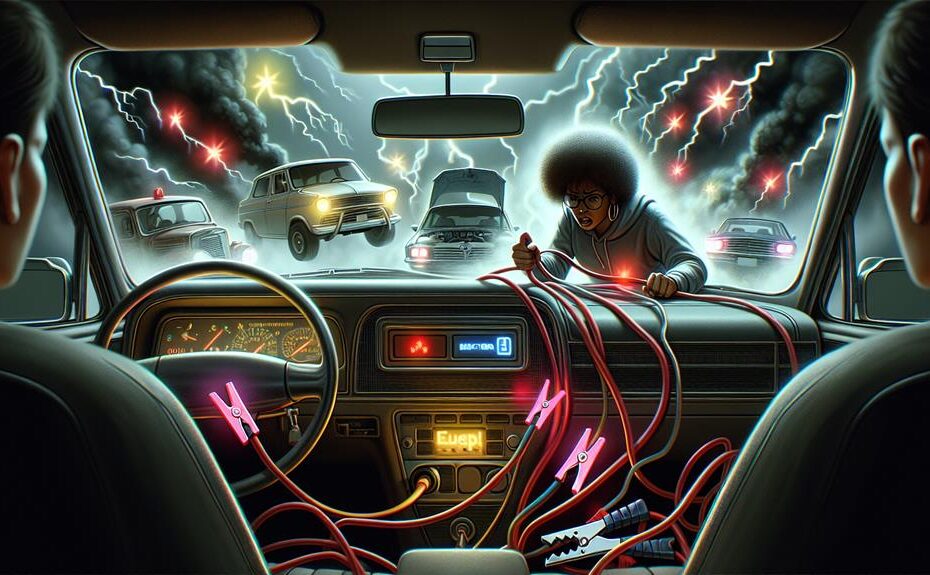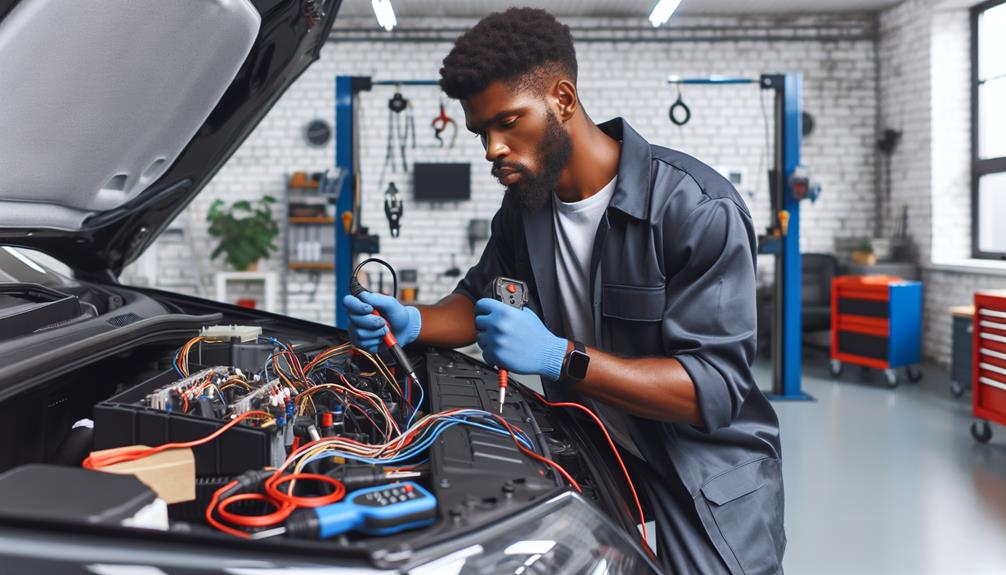Are you tired of dealing with car electrical system failures? Frustrated with the constant hassle of a dead battery or blown fuses? Well, fret no more!
We have compiled a list of the 9 best tips to help you tackle these issues head-on and get your car back on the road in no time.
From identifying the problem to seeking professional help, these tips will equip you with the knowledge and skills to handle any electrical system failure that comes your way.
So, buckle up and get ready to take charge of your car's electrical woes!
Key Takeaways
- Conduct a thorough diagnostic test using specialized equipment to identify the problem with the car's electrical system.
- Take safety precautions, such as disconnecting the battery and wearing protective gear, when working on the electrical system.
- Regularly check the battery for damage, corrosion, and proper voltage to prevent unexpected failures.
- Inspect the fuses for any issues, such as corrosion or blown fuses, and replace them if necessary. Consider seeking professional help if troubleshooting steps do not resolve the electrical issues.
Identifying the Problem
To identify the problem with your car's electrical system, you must first conduct a thorough diagnostic test using specialized equipment. Troubleshooting techniques are essential in narrowing down the underlying issue. Common signs of an electrical system failure include a dead battery, flickering lights, and malfunctioning electrical components.
When troubleshooting, start by checking the battery. A dead battery is often the culprit behind electrical problems. Use a multimeter to measure its voltage. If the reading is below 12.6 volts, the battery may need to be replaced.
Next, inspect the fuses. A blown fuse can cause specific electrical components to stop working. Use a test light to check for continuity in each fuse. If a fuse is blown, replace it with a new one of the same amperage.
Another troubleshooting technique is checking the alternator. Use a voltmeter to measure the voltage output while the engine is running. If the reading is below 13.8 volts, the alternator may be faulty and should be replaced.
Additionally, inspect the wiring harness for any visible damage or loose connections. A damaged wire or loose connection can cause intermittent electrical issues. Repair or replace any damaged wires and ensure all connections are secure.
Safety Precautions
Before you begin any work on your car's electrical system, it's important to take proper safety precautions to protect yourself and prevent any potential accidents or injuries. Working with car electrical systems can be dangerous if not done correctly. To ensure your safety, follow these guidelines.
Firstly, always disconnect the battery before starting any electrical work. This will prevent any accidental shocks or short circuits. Additionally, make sure to wear insulated gloves and safety goggles to protect yourself from any potential electrical hazards.
When troubleshooting electrical issues, it's important to have a clear understanding of the common causes. These may include blown fuses, loose connections, or faulty wiring. By identifying the root cause, you can proceed with the necessary repairs or replacements.
To safely troubleshoot your car's electrical system, follow these steps. Start by inspecting the fuse box and checking for any blown fuses. If a fuse is blown, replace it with a new one of the same rating. Next, examine all the wiring connections for any signs of damage or looseness. Tighten or repair any loose or damaged connections as needed. Finally, if the issue persists, consult a professional mechanic for further assistance.
Checking the Battery
Before checking the battery, ensure that the car's ignition is turned off and the headlights are switched off.
Checking the battery is an essential part of battery maintenance and troubleshooting techniques.
Start by visually inspecting the battery for any signs of damage or corrosion. Look for cracks, leaks, or loose connections. If you notice any of these issues, it may be necessary to replace the battery.
Next, using a digital multimeter, check the battery voltage. A fully charged battery should have a voltage reading of around 12.6 volts. If the voltage is significantly lower, it may indicate that the battery isn't holding a charge and needs to be replaced.
Additionally, check the battery terminals for any corrosion or buildup. Corrosion can hinder the flow of electricity and affect the battery's performance. If there's corrosion, clean the terminals using a mixture of baking soda and water. It's important to wear gloves and safety goggles when handling the battery to protect yourself from any potential hazards.
Regularly checking the battery can help prevent unexpected electrical system failures and ensure the proper functioning of your car.
Inspecting the Fuses
After thoroughly checking the battery, the next important step in troubleshooting a car's electrical system is inspecting the fuses. Fuses are designed to protect electrical components by breaking the circuit in case of a power surge or short circuit. Follow these troubleshooting techniques to effectively inspect the fuses:
- Locate the fuse box: The fuse box is usually located under the dashboard on the driver's side or in the engine compartment. Refer to the owner's manual to find the exact location.
- Test connections: Before inspecting the fuses, make sure to disconnect the car's battery to avoid any potential electrical shocks. Inspect the fuse connections for any signs of corrosion, loose wires, or burnt spots.
- Check the fuses: Using a fuse puller or needle-nose pliers, carefully remove each fuse one by one and visually inspect them for any signs of damage. Look for blown fuses, where the metal strip inside the fuse is broken.
Remember to use a multimeter to test the continuity of each fuse if visual inspection doesn't reveal any obvious issues. Replace any blown fuses with the correct rating to ensure the proper functioning of your car's electrical system.
Seeking Professional Help
You may need to consider seeking professional help if you have completed the previous troubleshooting steps and are still experiencing electrical issues with your car. While DIY troubleshooting techniques can be helpful in many cases, there are certain situations where the expertise of a professional is necessary to accurately diagnose and repair the problem.
One common cause of persistent electrical issues is a faulty alternator. The alternator is responsible for charging the battery and providing power to the electrical components of the car. If the alternator is malfunctioning, it can result in a variety of electrical problems such as dimming lights, a dead battery, or even a complete loss of power. A professional mechanic will have the necessary tools and knowledge to test the alternator and determine whether it needs to be repaired or replaced.
Another common cause of electrical issues is a short circuit. A short circuit occurs when there's a direct connection between the positive and negative terminals of the electrical system, causing a surge of electricity that can damage components and cause malfunctions. Locating and repairing a short circuit can be a complex and time-consuming process, requiring specialized equipment and expertise. A professional mechanic will have the skills and experience to accurately diagnose and repair the issue.
In addition to these common causes, there are many other potential culprits for electrical problems in a car. These can include issues with the wiring, battery, fuses, or even the car's computer system. A professional technician will be able to use their knowledge and diagnostic tools to identify the root cause of the issue and provide an effective solution.
Frequently Asked Questions
How Can I Prevent Car Electrical System Failure in the First Place?
To prevent car electrical system failure, follow these tips: regular car electrical maintenance, such as checking the battery, alternator, and wiring; avoid common causes of electrical system failure, such as overloading circuits or using incompatible accessories.
Can I Jump-Start My Car if the Electrical System Has Failed?
Yes, you can jump-start your car even if the electrical system has failed. However, it is important to take precautions and be aware of alternative solutions to starting the car with a faulty electrical system.
What Are the Signs of a Failing Alternator?
Are you experiencing dim headlights, a dead battery, or strange electrical issues? These are common signs of a failing alternator. To troubleshoot car electrical system issues, start by checking the alternator's voltage output and connections.
Is It Safe to Drive My Car With a Faulty Electrical System?
It is not safe to drive your car with a faulty electrical system. It can lead to potential hazards and breakdowns. Ensure regular car battery maintenance and troubleshoot any electrical problems promptly to ensure your safety on the road.
How Much Does It Typically Cost to Repair a Car's Electrical System?
Car electrical system repair costs can vary depending on the specific issue, but on average, it can range from $200 to $900. Common causes of car electrical system failure include faulty alternators, batteries, and wiring.
Conclusion
In conclusion, when faced with car electrical system failure, it's crucial to follow the steps outlined in this article to identify and address the issue.
Taking necessary safety precautions and checking the battery and fuses can often resolve the problem.
However, if the issue persists or is beyond your expertise, seeking professional help is highly recommended.
Remember, tackling these challenges with the right knowledge and assistance can ensure a smooth and efficient resolution, like a well-oiled machine.
- How to Easily Turn off Interior Lights in Volkswagen Tiguan 2021 - May 12, 2024
- How to Easily Defog Windshield Without AC: Quick Solutions - May 12, 2024
- How Big is 1.2 Cubic Feet: The Ultimate Guide to Measuring Volume - May 12, 2024



